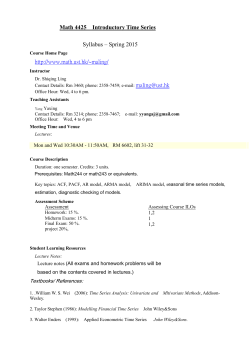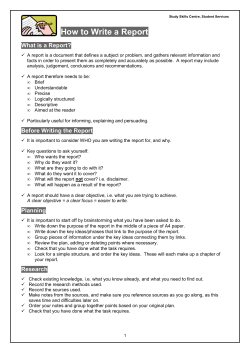
Third Edition of Process Dynamics and Control Recently
Third Edition of Process Dynamics and Control Recently Published John Wiley & Sons has recently published the Third Edition of Process Dynamics and Control by Dale E. Seborg, Thomas F. Edgar, Duncan A. Mellichamp, and Francis J. Doyle III. The third edition is a major revision of the 2004 Second Edition, and includes a new coauthor, Professor Francis J. Doyle III of UC-Santa Barbara. Process control has increased in importance over the past 30 years, driven by global competition, rapidly changing economic conditions, more stringent environmental and safety regulations, and the need for more flexible yet more complex processes to manufacture high value-added products. In order to accommodate these important trends, the Third Edition is divided into reasonably short chapters to make the book more readable and to enhance its use in a modular fashion. This organization gives the instructor the flexibility to cover just the topics that correspond to their syllabus without a loss of continuity. Student book costs can be reduced by using Wiley Flex to select partial or full electronic editions, or to create a custom version of the text including only what is covered in class. Wiley Flex is an innovative program designed to provide students with affordable options for purchasing their texts either in print or electronic form. Below are listed the Flex offerings for this text. Wiley Desktop Editions – A Wiley Desktop Edition of this title will be available! Wiley Desktop Editions are robust searchable, portable and permanent downloadable eBooks that students install and own on their computer. These Desktop Editions can save students up to 40% off the regular text price. Wiley Custom Select – This book can be offered in a custom version, with the price proportional to how much of the book the instructor chooses to use in his/her course. Ask your Wiley rep for more details, or visit www.customselect.wiley.com to learn more about customizing this Wiley book for your courses. New and expanded features in the Third Edition include: Two new chapters on the dynamics and control of biological systems New chapters on process safety and control applications at the process unit level Up-to-date information on real-time optimization, model predictive control, and process monitoring to highlight the significant impact these techniques now have on industrial practice. Numerous examples and simulations based on MATLAB® and LabVIEW® software packages, as well as a series of Process Control Modules based on distillation column and furnace simulations. A YouTube video describes the use of LabVIEW simulation examples in the book; see http://www.youtube.com/watch?v=mnO9pHXdzTE. New exercises to reinforce concepts and an updated solution manual. Power point slides available for instructors to modify and use. Table of Contents PART ONE: INTRODUCTION TO PROCESS CONTROL. Chapter 1. Introduction to Process Control. Chapter 2. Theoretical Models of Chemical Processes. PART TWO: DYNAMIC BEHAVIOR OF PROCESSES. Chapter 3. Laplace Transforms. Chapter 4. Transfer Function and State-Space Models. Chapter 5. Dynamic Behavior of First-Order and Second-Order Processes. Chapter 6. Dynamic Response Characteristics of More Complicated Processes. Chapter 7. Development of Empirical Dynamic Models from Process Data. PART THREE: CONTROL SYSTEM DESIGN ANALYSIS. Chapter 8. Feedback Controllers. Chapter 9. Control System Instrumentation. Chapter 10. Process Safety and Process Control. Chapter 11. Dynamic Behavior and Stability of Closed-Loop Control Systems. Chapter 12. PID Controller Design, Tuning, and Troubleshooting. Chapter 13. Control at the Process Unit Level. Chapter 14. Frequency Response Analysis and Control System Design. Chapter 15. Feedforward and Ratio Control. PART FOUR: ADVANCED PROCESS CONTROL. Chapter 16. Enhanced Single-Loop Control Strategies. Chapter 17. Digital Sampling, Filtering, and Control. Chapter 18. Multiloop and Multivariable Control. Chapter 19. Real-Time Optimization. Chapter 20. Model Predictive Control. Chapter 21. Process Monitoring. Chapter 22. Batch Process Control. PART FIVE: APPLICATIONS TO BIOLOGICAL SYSTEMS. Chapter 23. Biosystems Control Design. Chapter 24. Dynamics and Control of Biological Systems. APPENDICES. Appendix A: Digital Process Control Systems: Hardware and Software. Appendix B: Review of Thermodynamics Concepts for Conservation Equations. Appendix C: Control Simulation Software. Appendix D: Instrumentation Symbols. Appendix E: Process Control Modules. Appendix F: Review of Basic Concepts from Probability and Statistics Appendix G (web): Introduction to Plantwide Control Appendix H (web): Plantwide Control System Design Appendix I (web): Dynamic Models and Parameters Used for Plantwide Control Chapters Appendix J (web): Additional Closed-Loop Frequency Response Material Appendix K (web): Conform Mapping and the Principle of the Argument
© Copyright 2025













